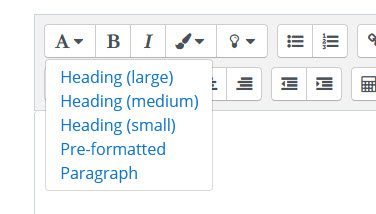Before You Begin
Consider the following question before you read further:
Which statement is true about an accessible heading in an electronic document?
- A heading is created by manually increasing the font size , changing the font style, and/or font colour of the heading text.
- A heading and its subheadings can be the same font size, style and colour
- A heading is created using the heading styles feature in the software program (e.g., Microsoft Word or Moodle)
- All the above
Introduction
Content headings allow the information to be organized in logical sections. They help break material down into logical chunks of information. When headings are used correctly then both a sighted and non-sighted reader can easily navigate the content. Unfortunately, making a heading by changing the font type, size and colour does not improve accessibility.
Download and compare the two documents below. Both will seem to have headings but only one is accessible.
In each document, check for heading styles:
- From the View menu, select the Navigation Pane.
- In the navigation pane, click the Headings tab where you will see all the heading styles used.
- To go to a heading in your document, click the heading in the navigation pane.
To add headings to the document without proper headings:
Select the text you want to mark as heading 1, then from the Home menu, click Heading 1
Check the Navigation Pane, Headings tab, to see that it worked, Continue to add headings.
Adding Headings
Headings should be sequential and nested. Headings are numbered from 1 (highest) to 6 (lowest). Typically only the first three to four heading levels are used.
A lower-level heading should represent a sub-heading under a higher-level heading and that no heading levels should be skipped as you progress downwards. Visually headings are styled to that the highest level (Heading 1) has the most visual prominence and each successively lower heading has a bit less prominence. The image below shows the simple progression of headings on left hand side of image and the logical structure of headings on right hand side.

Heading Styles in Text Editors
Most modern text editing environments have a method for adding structured headings. There are two common styles in which headings styles are displayed.
- Heading number listing as in Word.

- Size listing as in Moodle.

Both types work the same way as you can either select heading style before adding content OR you can add content and then select heading style. Each method will get the same results.
Other Benefits of Headings
- Allow all users (including yourself!) to easily see the structure of the document.
- Allow you to easily generate a Table of Contents
- Allow you to generate a PDF that has same level of accessibility.
Screenshots are from Microsoft Word. Used with permission from Microsoft.
Test Your Understanding
Now that you have read the Headings material answer the following question: